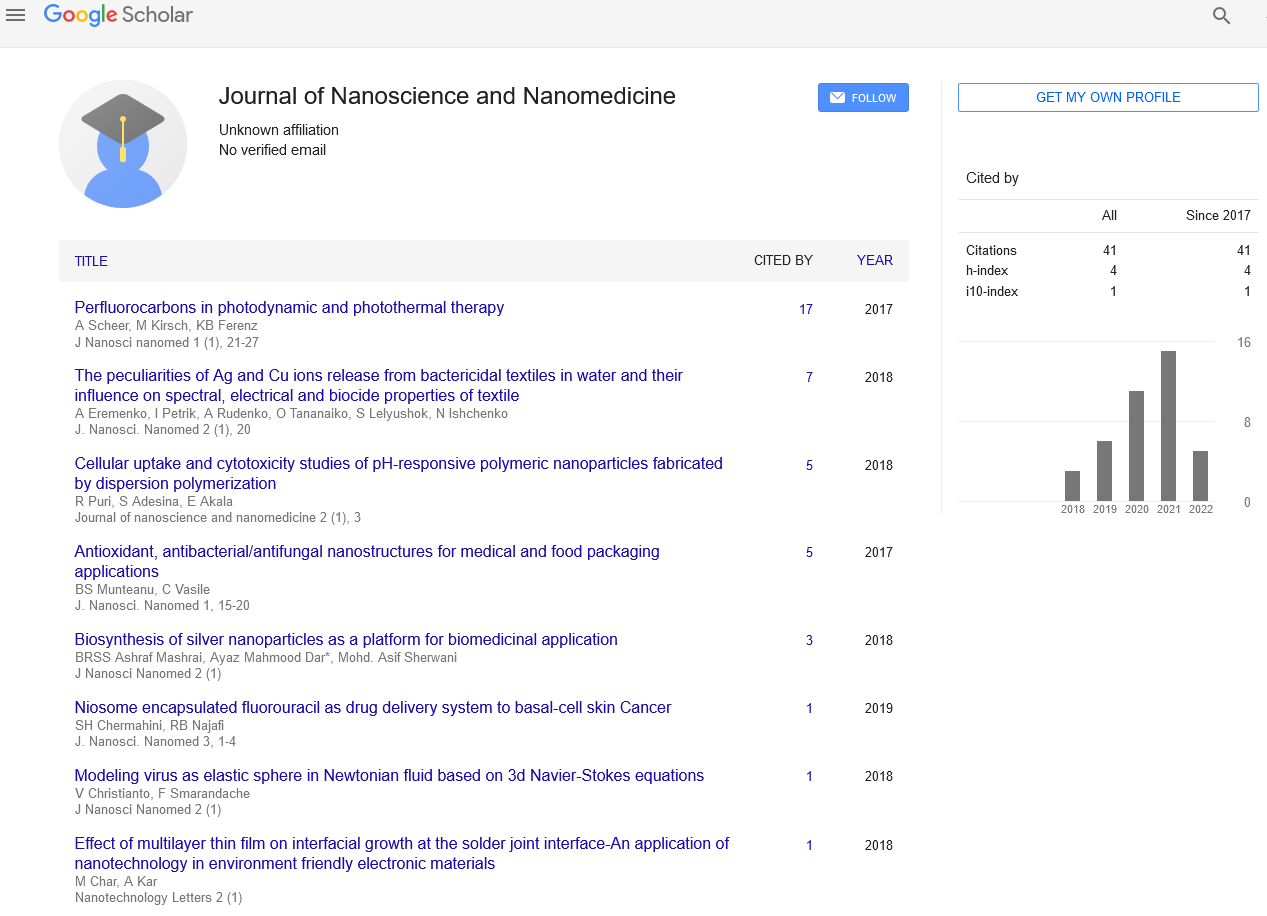A Polycrystalline Tungsten Trioxide Nanoparticle
Department of Chemical Engineering, University of California, Berkeley
, USA, Email: hornyakgobor@yahoo.comReceived: 09-Jul-2021 Accepted Date: Jul 23, 2021; Published: 30-Jul-2021
Citation: Gabor H. A Polycrystalline Tungsten Trioxide Nanoparticle. J Nanosci Nanomed 2021;5(4):5.
This open-access article is distributed under the terms of the Creative Commons Attribution Non-Commercial License (CC BY-NC) (http://creativecommons.org/licenses/by-nc/4.0/), which permits reuse, distribution and reproduction of the article, provided that the original work is properly cited and the reuse is restricted to noncommercial purposes. For commercial reuse, contact reprints@pulsus.com
Abstract
Tungsten minerals are treated with soluble bases to deliver WO3. Encourage response with carbon or hydrogen gas decreases tungsten trioxide to the immaculate metal. Tungsten trioxide (WO3) nanospheres with distance across extending from 10 nm to 500 nm were incorporated by a effortless warm oxidation handle. By resistively warming metallic tungsten in oxygen environment, WO3 nanoparticles were delivered in tall surrender
Keywords
Tungsten minerals, Tungsten trioxide, Oxidation, Nanoparticles
Introduction
Tungsten trioxide or tungstic anhydride, WO3, could be a chemical compound containing oxygen and the move metal tungsten. It is gotten as a middle of the road within the recuperation of tungsten from its minerals. In 1841, a chemist named Robert Oxland gave the primary strategies for planning tungsten trioxide and sodium tungstate. He was allowed licenses for his work before long after, and is considered to be the author of efficient tungsten chemistry [1]. Optical, compositional, morphological and basic considers were performed by UV-VIS-NIR spectrophotometry, X-ray photoelectron spectroscopy (XPS), checking electron microscopy (SEM) and X-ray diffraction (XRD) ponders. XPS thinks about uncovered the arrangement of tungsten trioxide with oxygen insufficiency [2].
Examination of the molecule estimate (distance across) dissemination of the as-deposited tests gotten from SEM micrograph shown a Gaussian-type dissemination centred around 178 nm and characterised by a half width of 98.3 nm. As found from XRD examination, the as-prepared tungsten trioxide (WO3) nanoparticles were polycrystalline in nature and solidified within the monoclinic stage. Electrophoretic statement (EPD) was connected in coating the incorporated tungsten oxide nanoparticles onto fluorine doped tin oxide (FTO) coated quartz substrates for the creation of dye-sensitised sun based cells (DSSC), with henna (Lawsonia inermis) as the characteristic natural color [3].
Nanoparticle suspension in twofold distilled water was utilized within the EPD handle with an ideal electric field of 20 Vcm−1 at a current thickness of 1 mA/cm2. DSSCs created utilizing these movies were tried through the estimation of their current density-voltage (J-V) and ghostly photocurrent characteristics. A most extreme IPCE of around 32% was gotten at around 450 nm. As of late, tungsten oxide has pulled in a extraordinary bargain of consideration due to its promising biomedical applications. WO3 nanoparticles unequivocally upgrade the perceivability of tissue structures in X-ray-based imaging procedures, to be specific, computed tomography (CT). The X-ray assimilation coefficient of tungsten (4.438 cm2/kg at 100 keV) is much higher than that of helpful CT differentiate operator iodine (1.94 cm2/kg at 100 keV) [4].
Tungsten oxide nanoparticles having photocatalytic properties have been connected in photothermal and photodynamic treatments. Tungsten oxide nanoparticles act as a radiation dose-intensifying operator amid radiation treatment and can be utilized as a theranostic operator for synchronous tumor CT imaging and treatment. The security and risk information on WO3 is accessible at PubChem. Tungsten oxide sol, containing exceedingly crystalline nanoparticles of orthorhombic WO3 and having great sedimentation steadiness, was synthesized employing a simple, ultrasonicassisted method. An extra steric stabilizer, dextran, was proposed to improve the solidness of WO3 nanoparticles in organic media and to decrease their in vivo poisonous quality. The cytotoxicity of dextran-stabilized and nonstabilized WO3 sols was examined in vitro utilizing dental mash stem (DPS) cell lines and breast cancer (MCF-7) cell lines [5].
REFERENCES
- Yuan G, Hua C, Khan S et al. “Improved electrochromic performance of WO3 films with size controlled nanorods.” Electrochimica Acta. 2018;260:274–280.
- Ahmad MZ, Sadek AZ, Ou JZ et al. “Facile synthesis of nanostructured WO3 thin films and their characterization for ethanol sensing.” Materials Chemistry and Physics. 2013;141(2-3): 912–919.
- Wang WQ, Wang X, Xia XH et al. “Enhanced electrochromic and energy storage performance in mesoporous WO3 film and its application in a bi-functional smart window.” Nanoscale. 2018;10(17):8162–8169.
- Xiong Y, Zhu Z, Guo T et al. “Synthesis of nanowire bundle-like WO3- W18O49 heterostructures for highly sensitive NH3 sensor application.” J Haz Mat. 2018;353:290–299.
- Adhikari S, Swain R, Sarkar D et al. “Wedge-like WO3 architectures for efficient electrochromism and photoelectrocatalytic activity towards water pollutants.” Molecular Catalysis. 2017;432(9):76–87.





